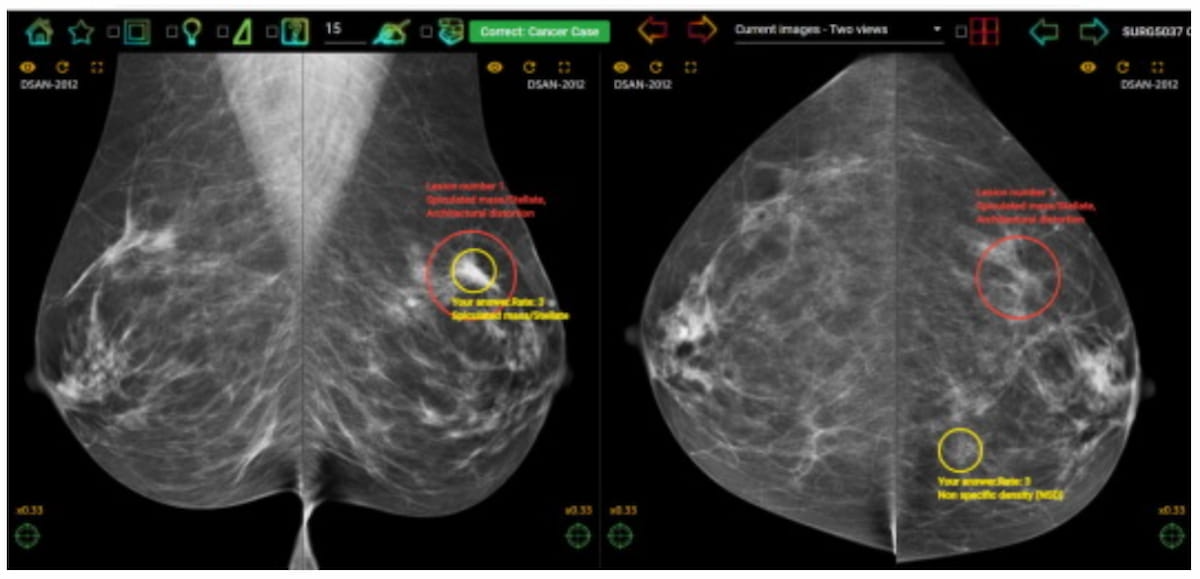How does the combination of lesion appearance, breast density, availability of prior mammography exams and case volume impact the ability of breast screening radiologists to diagnose breast cancer?
In a new study, recently published in the European Journal of Radiology, researchers examined these factors and their impact on true-positive and false-positive rates by assessing initial mammography interpretation of 540 women (average age of 60) by 869 breast radiologists in Australia.
For the reviewing radiologists, the researchers noted average mammography reviewing experience of eight years with 41 percent having five years or less experience and 17.1 percent having more than 20 years of experience. The study authors also noted an average mammography case volume ranging between 60 to 100 cases weekly.
The researchers noted a nine percent decrease in specificity rates with the highest breast density cases (75 percent) in contrast to cases involving low breast density (84 percent). There were also low sensitivity rates for asymmetric density (46 percent) and architectural distortion (57.4 percent) for women with high breast density (levels C and D), according to the study authors.
Overall, there was significantly higher sensitivity in cases without access to prior mammography exam findings (80.4 percent) in comparison to interpretation without access to prior findings (74.3 percent). Researchers also noted over a 14 percent higher true positive rate for spiculated masses without access to previous mammography images (79.5 percent vs. 65 percent).
“Our findings about readers’ performances when viewing digital mammography screening cases have indicated that breast density, the availability of prior images, and lesion appearances have a significant impact on the TP and FP rates,” wrote lead study author Phuong D. (Yun) Trieu, Ph.D., a senior lecturer in the Discipline of Medical Imaging Sciences with the Faculty of Medicine and Health at the University of Sydney in Camperdown, Australia, and colleagues.
Three Key Takeaways
- Impact of breast density on diagnostic accuracy. Higher breast density significantly reduces specificity in mammography screening, with dense breast cases showing a 9 percent drop in specificity compared to lower density cases. Sensitivity was also lower for high-density cases with lesions such as asymmetric density and architectural distortion.
- Availability of prior mammograms affects sensitivity. Radiologists' sensitivity was higher when prior mammography images were unavailable, particularly for spiculated masses. This suggests that access to previous images may sometimes introduce biases that reduce true positive rates.
- Case volume correlates with diagnostic accuracy. A positive correlation exists between the number of mammography cases reviewed per week and true positive rates. The study authors noted that reading at least 100 cases weekly led to an 80 percent rate of true-positive assessments whereas 150 cases a week were necessary to achieve the same true-positive threshold rate for detecting malignant calcifications.
Employing a benchmark true-positive rate of 80 percent, researchers found that review of 100 mammography cases per week is necessary to achieve that accuracy level for architectural distortion, asymmetric density, and masses. They also estimated that interpretation of 150 mammography cases weekly would be necessary to achieve that standard for detection of malignant calcification.
“The findings from our study showed a positive correlation between TP rate and the number of cases read per week in almost all lesion types, while the FP rate for discrete masses and calcifications demonstrated a negative correlation with case volume,” noted Trieu and colleagues.
(Editor’s note: For related content, see “AI Mammography Platform Shows Promising Results for Detecting Subclinical Breast Cancer,” “Study: Contrast-Enhanced Mammography Offers Significantly Higher Sensitivity for Breast Cancer in Dense Breasts” and “How Does Access to Previous Mammography Exams Impact Current Mammography Interpretation by Radiologists?”)
In regard to study limitations, the authors acknowledged the use of cancer-enriched test sets. They also noted that some lesion types were under-represented in the test sets, limiting broader conclusions about detection of these less common breast cancer lesions.
